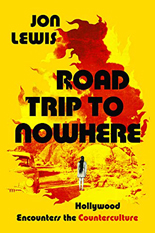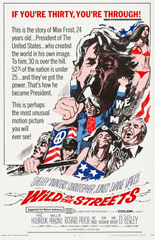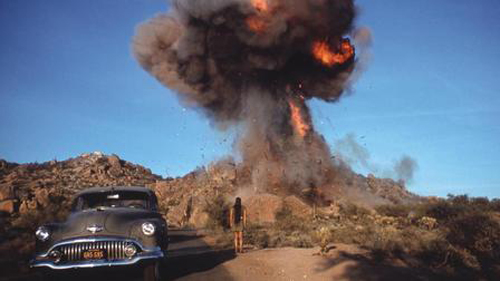
 Writes Jon Lewis in his introduction to his new book, “In counterculture Hollywood there were any number of road trips, and most of them … led nowhere, at least nowhere good.” The next 251 pages prove that true. But out of “nowhere good” comes greatness, because Road Trip to Nowhere: Hollywood Encounters the Counterculture is the smartest, most fascinating film book 2022 has brought.
Writes Jon Lewis in his introduction to his new book, “In counterculture Hollywood there were any number of road trips, and most of them … led nowhere, at least nowhere good.” The next 251 pages prove that true. But out of “nowhere good” comes greatness, because Road Trip to Nowhere: Hollywood Encounters the Counterculture is the smartest, most fascinating film book 2022 has brought.
Don’t be put off by its publication from University of California Press or Lewis’ day job as a college film professor; it’s as accessible as it is intelligent (mangling of Cybill Shepherd’s name as “Cybil Shepard” aside).
The second word of Road Trip to Nowhere’s title should be plural, for its structure is vignette-driven: four separate essays with the commonality of time, place and mood. At roughly 60 pages apiece, do the individual pieces of Lewis’ quartet flow into a whole? Not really. Do I care? Not a whit. Each chapter is utterly fascinating and intoxicating in its mix of criticism and cultural history, reminiscent of the pleasures of Charles Taylor’s Opening Wednesday at a Theater or Drive-In Near You: The Shadow Cinema of the American ’70s.
Lewis starts with the stories behind a pair of key youthquake movies. The first, Dennis Hopper’s independent Easy Rider, proved such a from-nowhere hit, it sent an empty-handed studio system into panic mode. The second, Michelangelo Antonioni’s Zabriskie Point, is one of the panic-spawned results — and proof the suits didn’t have a clue at how out of touch they were with the a-changin’ times. (For those interested in more on Zabriskie and the literal cult from which its doomed lead was cast, I highly recommend Ryan H. Walsh’s Astral Weeks: A Secret History of 1968.)
Next, “Christopher Jones Does Not Want to Be a Movie Star” chronicles the quick rise and quicker flameout of Jones, a troubled youth briefly turned into AIP’s top dog at the box office, thanks to a resemblance to James Dean — all in the face, not talent. After climbing from B-movie maven Samuel Z. Arkoff to A-list director David Lean, he walked away from it all … and into homelessness, yet another sad casualty of Tinseltown.
 Chapter three is similar, but charts the paths of four actresses of varying fame: Jean Seberg, Jane Fonda, Dolores Hart and Barbara Loden. That only two got happy endings says a great deal about the system’s meat-grinding machinations; that one of those happy endings required getting thee to a nunnery says a great deal more.
Chapter three is similar, but charts the paths of four actresses of varying fame: Jean Seberg, Jane Fonda, Dolores Hart and Barbara Loden. That only two got happy endings says a great deal about the system’s meat-grinding machinations; that one of those happy endings required getting thee to a nunnery says a great deal more.
Finally, Lewis considers Charles Manson. And really, how could he not? As Lewis posits, “Being counterculture in Hollywood meant one thing before August 1969 and something else again afterward.” Rather than simply revisit the details of Sharon Tate’s slaughter, Lewis tells a cautionary tale of Hollywood with “unsavory characters” in its orbit, from Manson back to the horrific dissection of Black Dahlia Elizabeth Short in 1947 and the unsolved murder of actor William Desmond Taylor in 1922. The line from one to the next is so smoothly drawn, it may as well be the Pacific Coast Highway.
With Road Trip to Nowhere somehow being my first exposure to Lewis, I grew anxious when I hit its halfway point, facing an inevitably end. Immediately, I ordered two more Lewis titles of film history, Hard-Boiled Hollywood and Hollywood v. Hard Core. For Road Trip, I can think of no finer praise than that. To borrow chapter four’s last line, “The defense rests.” —Rod Lott

